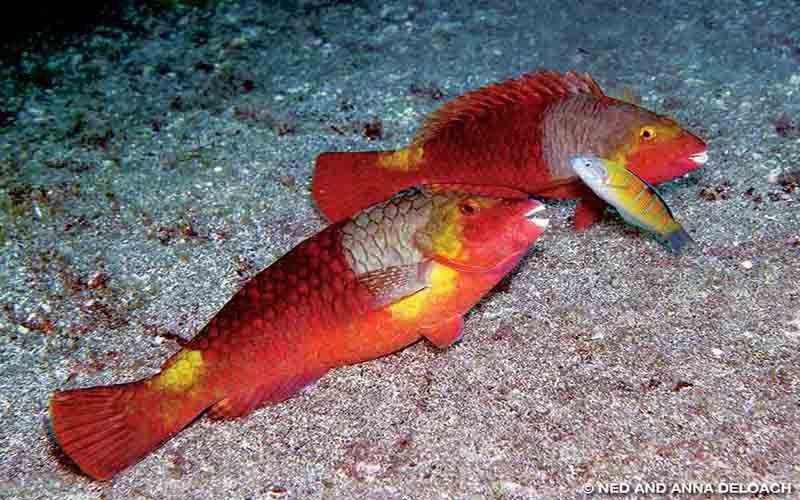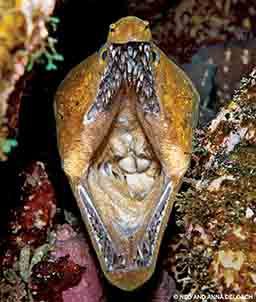From the summit of Monte da Guia, we see a pair of sea-breached calderas (volcanic craters) that takes our breath away. Adding to their allure, the seductive pools and surrounding waters have been protected for decades as marine reserves, which means plenty of fish — and fish are a big part of why Anna and I are visiting the isolated Atlantic islands of the Azores. We’re part of a contingent of Reef Environmental Education Foundation (REEF) fish surveyors who are beta testing a fish-population survey protocol designed in cooperation with the local university.
Since we stepped off the plane on the island of Faial, this far-flung speck of land has worked its magic. And the spell continues as our group contemplates the archipelago from atop the island’s 475-foot volcanic cone. Forged by a series of submarine eruptions powered by the collision of three massive tectonic plates, Faial and its eight sister islands began to rise off the seafloor some 10 million years ago.
To the east of our perch, beyond the red-roofed hill town of Horta, 1,000 miles of uninterrupted ocean separate this autonomous region from its mother country, Portugal. To the west, you would have to sail 2,500 miles before reaching dry land. The novelty of visiting such a remote destination has us firmly in its grip as we head back down the road to Horta’s picturesque port for a fresh seafood dinner.

The Azores have long been popular as a big-animal destination with whale-watching excursions and offshore manta, mobula and blue shark dives as regular happenings. The chilly North Atlantic waters are also home to a stylish population of shore fishes. These are the animals we’re after. But first we have to find them.

Nearly every island seems to have a bearded, bandana-headed, too-full-of-himself character running a dive operation, who everybody sidesteps on day one but adores by trip’s end. Horta has Norberto. On land he’s laid-back but efficient; underwater he’s a wizard. On our third day out, Norberto mentions Anthias, which brings to mind Barcelona.
While visiting that city’s aquarium years earlier, Anna and I were stopped in our tracks by a tank full of flashy little seaperch dripping with fins. According to the tank’s label we were looking at the mother of all Anthias species: Anthias anthias, described in 1758 by Carolus Linnaeus, the father of modern taxonomic nomenclature. The species’ intriguing repetitive Latin name, known as a tautonym, is an artifact of Linnaeus’ day when many classifications not only described new species but also assigned a primary, or generic, group name. Thus Linnaeus is responsible for creating such iconic fish tautonyms as Mola mola (ocean sunfish), Remora remora (common remora), Histrio histrio (Sargassum frogfish) and Anthias anthias (swallowtail seaperch).

Believing at that time we would never dive in temperate water, we lingered, looking longingly at the fish with little hope of ever seeing the memorable species in the wild. But unexpectedly, here we are in the Azores, and Norberto knows where to find Anthias anthias.
As predicted, the wind sufficiently dies during the night for us to dive on the seaward side of the mountain, where just off the mooring line, Norberto assures us, clouds of Anthias gather along the wall at 90 feet. “A piece of cake,” he mutters as three of us bail out backward and head down the slope.
The nippy water is reasonably clear but dark in the mountain’s early morning shadow. There are no Anthias to be found at 90 feet, so we continue down, swimming past gray boulders as big as railroad cars. Eventually a scattering of the golden sea bass appear in the dim light. A male with exaggerated fins catches my eye and leads me on a chase down the incline before finally slowing and falling in with a group of females at 130 feet.
Even though there were far fewer Anthias than we had hoped, I’m delighted to have encountered the historic fish in its home waters. At the same time, I’m relieved that the mission is over and glad to be heading up and out of the gloom. Norberto suddenly appears out of the shadows and motions me over to a cavern entrance large enough to easily slip inside. The dark chamber is packed ceiling to floor with big bug-eyed shrimp hovering in the passageway and covering the walls. Toward the back of the opening my light strikes what all the fuss is about: A 5-foot dusky grouper lies like a log next to the wall as hungry shrimp swarm over its bulky body like a horde of locusts — possibly one of the most remarkable cleaning stations I’ve ever seen.
| © Alert Diver — Q2 2018 |